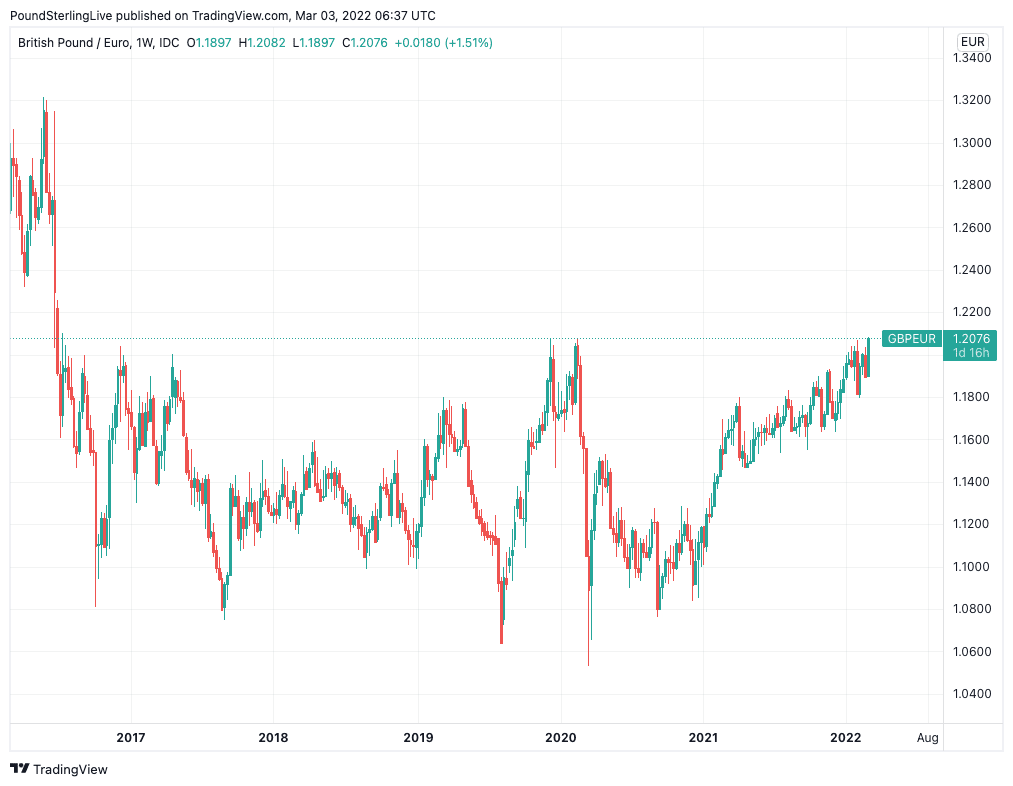GBP/EUR Hits Post-EU Referendum Best, Hopes Build for Ukraine Ceasefire
- Written by: Gary Howes
-
- GBP/EUR at 5-year highs
- As investor sentiment improves
- Hopes for Ukraine ceasefire build
- UK bond yields recover from Tuesday's slump

Image © Adobe Images
Gains the past 24 hours takes Pound Sterling to its highest level against the Euro since 2016 and the immediate aftermath of the EU referendum.
The Pound to Euro exchange rate printed a high at 1.2082 on March 03, surpassing the December 2019 peak at 1.2081, and registering its highest level since July 1016.
Pound Sterling rallied as UK government bond yields recovered following their sharpest one-day fall since the Brexit referendum on Tuesday and investor sentiment improves on hopes Ukraine and Russia will seek to negotiate a ceasefire.
Newswires reported over recent hours that Russian negotiators had said a ceasefire was indeed on the agenda at talks with Ukraine.
The Russian delegation on Wednesday made itself available for a second round of Russian-Ukrainian talks, the Belarusian state-run news agency BelTA said on Wednesday.
Ukraine confirmed a second round of talks were indeed happening, but the venue was not yet decided.
Above: GBP/EUR at weekly intervals.
- Reference rates at publication:
GBP to EUR: 1.2078 - High street bank rates (indicative): 1.1755 - 1.1840
- Payment specialist rates (indicative): 1.1969- 1.2018
- Find out more about specialist rates and service, here
- Set up an exchange rate alert, here
The incessant stream of negative headlines surrounding the conflict and subsequent sanctions on Russia had pushed stock markets lower as well as European G10 currencies such as the Pound, Euro, Krone and Krona.
Any relief could therefore trigger a covering of bearish positioning and allow for a recovery in these currencies.
"Just as sterling has depreciated significantly from the Russia-Ukraine situation, it has significant room to appreciate as markets increasingly see this conflict as localised and global risk has begun to rebound," says analyst Marek Raczko at Barclays.
The Euro was meanwhile unable to shake off much of the recent negativity, ensuring Pound-Euro pushes to multi-year highs.
"We believe investors should underweight the Euro area in both the currency and the equity space given its vulnerability to any further escalation," says Marko Kolanovic, an economist with JP Morgan.
But in a note to clients this week Kolanovic lists six reasons why he believes the worst might now have passed for 'risk' assets:
- the announced sanctions, though severe, appear to have limited impact on economic growth;
- energy price increases have been contained so far;
- CB hawkishness is likely tempered by geopolitical risks;
- the conflict is unlikely to spread to other Eastern European countries that are NATO members;
- US tech approached oversold conditions;
- the rise in oil prices should create some supportive flows for equities via SWF accumulation and oil company buybacks.
If markets are able to recover the pro-cyclical and pro-risk Pound can also outperform.
"In our view, the EURGBP downtrend remains intact. With volatility likely to remain elevated while the Ukraine war rages, moves higher in EURGBP should be regarded as an opportunity to establish long pound positions against the euro," says Thomas Flury, Strategist, at UBS.
UBS keep a Euro-Pound target for June-September at 0.81, this is a Pound-Euro target of 1.2346.
But a major development this week has been the big moves in interest rate markets - an unsexy yet incredibly important driver of the British Pound and the broader foreign exchange market.
The yield paid on UK government bonds (gilts) fell sharply on Tuesday, largely in response to a fall in the number and pace of Bank of England interest rate hikes the market anticipates in 2022 and 2023.
The Pound is highly sensitive to moves in these yields, rising when they rise and falling when they fall.
"The 28bp drop in 10-year gilt yields on Tuesday was the largest daily decline since the E.U. referendum," says Samuel Tombs, Chief UK Economist at Pantheon Macroeconomics.
The move predictably corresponded with all-round weakness in the Pound.
"Most of the decline in gilt yields can be explained by changes in expectations for monetary policy, indicating that investors believe that the MPC will be more responsive to the impact of higher energy prices on domestic demand than their impact on CPI inflation," says Tombs.
The market has reduced sharply its expectations for Bank of England rate hikes in 2022 and 2023 as investors fear UK economic growth will disappoint amidst surging inflation and geopolitical uncertainty.
This in turn impacts negatively on bond yields.
But yields recovered on Wednesday and the Pound-Euro exchange rate reacted accordingly:
Above: GBP/EUR at four hour intervals (top) and UK ten year bond yields (bottom).
Secure a retail exchange rate that is between 3-5% stronger than offered by leading banks, learn more.
UK gilt yields and the Pound should stay supported as long as investors remain of the view the Bank of England will continue to raise interest rates faster and further than the European Central Bank in 2022 and 2023.
Explaining the recent moves in bond yields Tombs says "it remains difficult to attribute a macroeconomic trigger to the sharp decline in yields on Tuesday. Indeed, MPC members so far have been silent on what they think Russia's invasion means for U.K. monetary policy.
"As a result, it is plausible that the sharp decline in gilt yields might also reflect some leveraged investors liquidating positions and some portfolio rebalancing decisions that took time to go
through investment committees," he explains.
Nevertheless, most economists are in agreement that a stabilisation in investor sentiment regarding the Russia-Ukraine conflict should support bond yields, which would in turn support those currencies that benefit in a high yield environment.
Such as Sterling.
"While gilt yields could drop further if the war in Ukraine escalates much further and/or it becomes clear that it is significantly reducing economic activity in the UK, at the moment we think gilt yields are more likely to rise over the next two years," says a note from Capital Economics released March 02.

